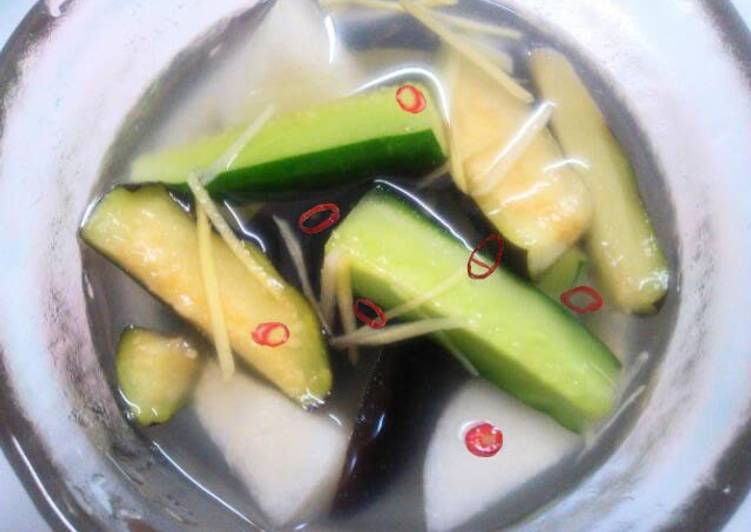Eggplant and Cucumber Mul (Water) Kimchi. Korean Water Kimchi (Mul Kimchi) is a wonderfully cooling summer kimchi made with radishes in slightly sweet brine. WATER KIMCHI may not really sound appetizing but it is absolutely refreshing and delicious. And it's quite simple to make.
 Red pepper powder is available at Asian/Korean markets.
The only ingredient should be red.
Water kimchi is a refreshing side dish for the summer.
You can cook Eggplant and Cucumber Mul (Water) Kimchi using 11 ingredients and 10 steps. Here is how you achieve it.
Red pepper powder is available at Asian/Korean markets.
The only ingredient should be red.
Water kimchi is a refreshing side dish for the summer.
You can cook Eggplant and Cucumber Mul (Water) Kimchi using 11 ingredients and 10 steps. Here is how you achieve it.
Ingredients of Eggplant and Cucumber Mul (Water) Kimchi
- Prepare 3 of Eggplant.
- Prepare 2 of Cucumbers.
- Prepare 1/4 of Apple.
- You need 1/2 clove of Garlic.
- You need 3 slice of Sliced ginger.
- Prepare 1 tsp of Red chili peppers (sliced into rounds).
- It's 1 tsp of Salt.
- You need 350 ml of ● Water.
- Prepare 1 tsp of Joshinko (or mochiko).
- You need 1 tsp of ● Sugar.
- It's 1 tsp of Rock salt (or regular salt).
During the hot days, this Mul kimchi will taste great and cool you down. Water (mul) kimchi is a fermented water based kimchi that is refreshing and tangy with effervescence. Plant based, gluten free, dairy free and delicious. Make it with just about any fruit or vegetables and get your healthy nutritious probiotics.
Eggplant and Cucumber Mul (Water) Kimchi step by step
- Thinly slice the garlic and ginger. You can actually cut them however you like, but don't grate them or they will cloud up the brine..
- Put all of the ● ingredients into a pot and turn on the heat. Mix them together well, and when it starts to simmer turn off the heat. Once it has cooled, add the garlic and ginger..
- Cut the eggplant and cucumbers into sticks and apply salt (about 1/2 teaspoon to each). For details on how to prepare eggplant, refer to https://cookpad.com/us/recipes/147048-technique-for-preparing-delicious-eggplant.
- Peel the apple and slice into 5 mm thick wedges. Fruits go great in mul kimchi..
- Take the dehydrated eggplant and cucumber, the apple, and red chili peppers and add to the brine from Step 2. Adjust the amount of salt. If it's too salty, add some water..
- [Fermenting] Transfer to a container and leave at room temperature for about 2 hours to half a day in summer, 2-3 days in spring or fall, or 4-5 days in winter. Then store it in the refrigerator..
- As it ferments, the color of the vegetables will change and it will become thicker and more acidic. Decide when you want to eat it and enjoy..
- [Mul kimchi juice] The juice, brimming with plant-based lactobacillus, is supposed to be very good for your body. It has about 20 times more lactobacillus as nukazuke pickles..
- [Using leftovers] Tomato mul kimchi using leftover juice https://cookpad.com/us/recipes/153321-using-leftovers-for-tomato-mul-water-kimchi.
- Daikon radish and pear mul kimchi https://cookpad.com/us/recipes/156050-radish-and-pear-mul-water-kimchi.
Vegetables, such as eggplant, carrot, beet, and cucumber, are then placed into the nukadoko and Kimchi is usually produced as follows. First, the Chinese cabbage and other vegetables (especially In a second step, the salted vegetables are washed with fresh water, drained and then mixed with the. oi sobagi (cucumber kimchi) ©ducdao/Fotolia. If you've always loved pickled cucumbers and for some reason dreamed of the day when science would invent Nabak kimchi, often called mul (water) kimchi, is only minimally spicy. It's made from radish sliced delicately into small thin squares, thinly. Quarter cabbage from top to bottom and remove the solid mass at the root end.